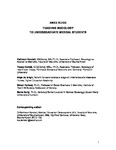Teaching sociology to undergraduate medical students
| dc.contributor.author | Kendall, K | |
| dc.contributor.author | Collett, Tracey | |
| dc.contributor.author | de Iongh, A | |
| dc.contributor.author | Forrest, S | |
| dc.contributor.author | Kelly, M | |
| dc.date.accessioned | 2022-02-11T11:31:08Z | |
| dc.date.available | 2022-02-11T11:31:08Z | |
| dc.date.issued | 2018-10-08 | |
| dc.identifier.issn | 0142-159X | |
| dc.identifier.issn | 1466-187X | |
| dc.identifier.uri | http://hdl.handle.net/10026.1/18747 | |
| dc.description.abstract |
Understanding the social basis of health and medicine and the contexts of clinical care are essential components of good medical practice. This includes the ways in which social factors such as class, ethnicity, and gender influence health outcomes and how people experience health, illness, and health care. In our Guide we describe what sociology is and what it brings to medicine, beginning with the nature of the "sociological imagination." Sociological theory and methods are reviewed to explain and illustrate the role of sociology in the context of undergraduate medical education. Reference is made to the 2016 report, A Core Curriculum for Sociology in UK Undergraduate Medical Education by Collett et al. Teaching and student learning are discussed in terms of organization and delivery, with an emphasis on practice. Sections are also included on assessment, evaluation, opportunities, and challenges and the value of a "community of practice" for sociology teachers in medical education. | |
| dc.format.extent | 1201-1207 | |
| dc.format.medium | Print-Electronic | |
| dc.language | en | |
| dc.language.iso | en | |
| dc.publisher | Taylor and Francis | |
| dc.subject | Attitude of Health Personnel | |
| dc.subject | Curriculum | |
| dc.subject | Education, Medical, Undergraduate | |
| dc.subject | Humans | |
| dc.subject | Models, Educational | |
| dc.subject | Sociology, Medical | |
| dc.subject | Students, Medical | |
| dc.subject | Teaching | |
| dc.title | Teaching sociology to undergraduate medical students | |
| dc.type | journal-article | |
| dc.type | Journal Article | |
| plymouth.author-url | https://www.webofscience.com/api/gateway?GWVersion=2&SrcApp=PARTNER_APP&SrcAuth=LinksAMR&KeyUT=WOS:000455215900002&DestLinkType=FullRecord&DestApp=ALL_WOS&UsrCustomerID=11bb513d99f797142bcfeffcc58ea008 | |
| plymouth.issue | 12 | |
| plymouth.volume | 40 | |
| plymouth.publication-status | Published | |
| plymouth.journal | Medical Teacher | |
| dc.identifier.doi | 10.1080/0142159x.2018.1505038 | |
| plymouth.organisational-group | /Plymouth | |
| plymouth.organisational-group | /Plymouth/Faculty of Health | |
| plymouth.organisational-group | /Plymouth/Faculty of Health/Peninsula Medical School | |
| plymouth.organisational-group | /Plymouth/Users by role | |
| plymouth.organisational-group | /Plymouth/Users by role/Academics | |
| dc.publisher.place | England | |
| dcterms.dateAccepted | 2018-06-19 | |
| dc.rights.embargodate | 2022-2-12 | |
| dc.identifier.eissn | 1466-187X | |
| dc.rights.embargoperiod | Not known | |
| rioxxterms.versionofrecord | 10.1080/0142159x.2018.1505038 | |
| rioxxterms.licenseref.uri | http://www.rioxx.net/licenses/all-rights-reserved | |
| rioxxterms.licenseref.startdate | 2018-10-08 | |
| rioxxterms.type | Journal Article/Review |


